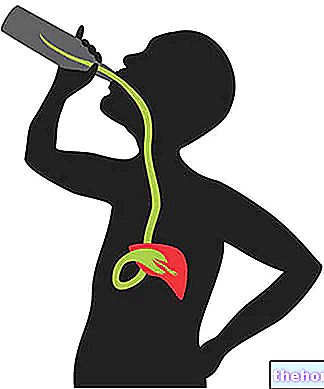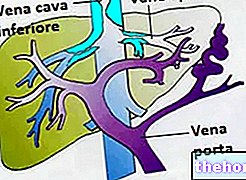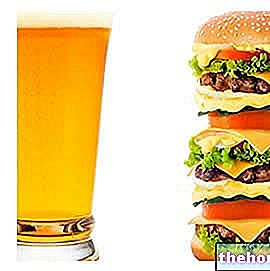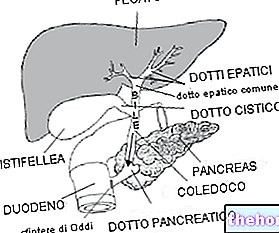Generality
Fatty liver disease, known to most as fatty liver, is the most common and widespread alcoholic liver disease. It is a completely reversible condition that results in an accumulation of triglycerides in the liver. As a result, there is an increase in the volume of the organ (hepatomegaly), which can give small signs of suffering from functional overload:
- widespread pain in the right upper abdominal quadrant (hepatic tenderness),
- nausea and mild elevation of transaminases in the blood.
- More rarely, alcoholic steatosis is associated with signs of cholestasis up to full-blown jaundice.

Causes and Subjects at Risk
Alcoholic steatosis is recorded in 60-100% of heavy drinkers, while the so-called NON-alcoholic steatosis is mainly the prerogative of overweight or obese people, who follow a disordered, high-calorie and high-fat diet. Naturally, the sum of the two conditions - heavy alcohol consumption, obesity and a high-calorie / hyperlipidic diet - increases the stress for the liver, which at first expresses its discomfort with an accumulation of triglycerides in its cells.
Why does alcohol consumption cause steatosis?
- facilitates intestinal absorption of chylomicrons;
- increases peripheral lipolysis, with an increase in the amount of fatty acids reaching the liver;
- it depresses the oxidation of fatty acids in the mitochondria of hepatocytes;
- stimulates the synthesis of fatty acids in the liver;
For what has been said - although the name may be misleading - alcoholic steatosis is not necessarily synonymous with alcoholism: the two conditions, in fact, can coexist but also express themselves individually. There are therefore alcoholics with an almost normal liver, especially in the early stages, and occasional heavy drinkers not yet "slaves of" alcohol, suffering from hepatic steatosis of alcoholic origin. The diagnosis of alcoholism is generally made through an interview with family members ( the alcoholic often tends to deny his condition), the medical history and the compilation - by the interested party - of questionnaires, such as CAGE, AUDIT (can be performed online on this page) or MALT, possibly supported by laboratory analysis specifications: Gamma-Glutamyl-Transpeptidase (GGT) dosage, mean globular volume (VGM or MCV) and carbohydrate-deficient transferrin (CDT).
Complications
In a more advanced stage, if left untreated, alcoholic steatosis can slowly progress to alcoholic hepatitis, more correctly defined as alcoholic steatohepatitis. In similar circumstances, the accumulation of triglycerides in the liver is associated with inflammation of the organ, which in turn can evolve or be associated with more or less extensive scarring processes (fibrosis up to liver cirrhosis).
About 10-15% of alcoholics show typical signs of cirrhosis on post-mortem examination. Therefore, while steatosis is a precise consequence of excessive ethanol intake, alcoholic hepatitis and cirrhosis develop in a more limited number of subjects .
Risk factors
How many grams of alcohol do you take with a drink?
Specify the quantities of alcohol consumed
ml of beer (3.5% alcohol)
ml of beer (5% alcohol)
ml of beer (7.5% alcohol)
ml of wine (10% alcohol)
ml of wine (12.5% alcohol)
ml of wine (15% alcohol)
ml of wine-based cocktails (20% alcohol)
ml of liqueurs (30% alcohol)
ml of liqueurs (40% alcohol)
ml of liqueurs (60% alcohol)
ml of liqueurs (70% alcohol)
Grams of alcohol taken:
The liver diseases described in the article are the typical consequence of alcohol abuse, since the liver is the main organ involved in the metabolism of alcohol. Unfortunately, due to the heterogeneity of the clinical manifestations, it is not possible to define the threshold of alcohol consumption beyond which there is the risk of developing steatosis and alcoholic liver disease in general. As a general fact, the dose currently considered toxic for most individuals is higher than 40-80 g of alcohol per day, even if - it should be reiterated - due to individual intervariability it is difficult to predict the consequences of alcohol on one's own body. It should also be noted that prolonged daily consumption is more harmful than occasional consumption, so much so that it is recommended not to take alcohol for at least two days a week. Finally, the risk of alcoholic steatosis and other liver diseases is - for the same amount of alcohol consumed - greater for women, so much so that for women, alcoholic doses of 30% lower than those indicated for men are considered toxic.
Alcoholic steatosis treatment
As anticipated, alcoholic steatosis is reversible, even in severe forms, within a couple of weeks from the "cessation of" alcoholic abuse. In fact, as logic dictates, alcohol abstinence is the most important and essential among therapeutic measures. General dietary intervention is also important, with the adoption of a diet enriched with "lean" proteins and vitamins. (especially those of group B, as well as C and K) according to medical indications.
Continue: Drugs for the Treatment of Alcoholic Steatosis "
Other Alcoholic Alchermes Alcohol test Alcopops Cocktail Alcoholic Alcoholic units calculation Cognac Gin Grappa Alcoholic degree Grappa Limoncino Maraschino Marsala Nocino Prosecco Rum Rum Sherry Sparkling wine Spirits Wine Port wine Vermouth Vodka Vov Whiskey Categories Alcoholic foods Meat Cereals and derivatives Sweeteners Sweets Offal Dried fruit Milk and derivatives Legumes Oils and fats Fish and fishery products Cold cuts Spices Vegetables Health recipes Appetizers Bread, Pizza and Brioche First courses Second courses Vegetables and salads Sweets and desserts Ice creams and sorbets Syrups, liqueurs and grappas Basic preparations ---- In the kitchen with Leftovers Carnival recipes Christmas recipes Light diet recipes Women's, mom's and dad's day recipes Functional recipes International recipes Easter recipes Celiac recipes Diabetic recipes Holiday recipes Valentine's Day recipes Vegetarian recipes Protein recipes Regional recipes Vegan recipes





























